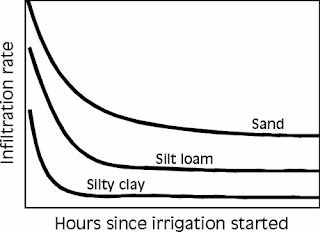3.1 What is the infiltration?
Infiltration
is a flow of water through the soil surface.
Infiltration effects to runoff, transpiration, and evaporation.
Infiltration effects to runoff, transpiration, and evaporation.
Infiltration capacity- With time, infiltration is
decreased and infiltration capacity has remained constant. Pores in the soil are
less filled with water before precipitation. When precipitation has occurred,
pores are getting to fill water. After saturation of all pores in the soil, water
cannot be absorbed anymore, therefore, infiltration capacity has become constant.
3.2 Factors affecting infiltration
(1) Rainfall
-Intensity (When infiltration
capacity is higher than rainfall capacity, all the rain is infiltrated. When
rainfall intensity is higher than infiltration capacity, infiltration is less
and runoff has occurred.)
-Duration
(Duration of rainfall is high, infiltration is less and runoff has occurred after a few hours.)
(2) Climate
-When the temperature is relatively
high, the rate of microbial activities is high.
Therefore relatively more amount of organic matter is added to soil
surface cover so soil particles are well aggregated so the size of pores is large
and infiltration capacity is relatively high.
(3) Soil characters
-Soil type(Light color soils such as sandy soils
have relatively larger infiltration capacity than heavy soils such as clay
soils because sandy soils have relatively larger pores that are well connected
together than clay soils.)
-Compaction(Compacted soils have
relatively lower infiltration capacity than loose soils because of size and amount
of pores in compacted soil is relatively very small therefore compacted soils
have less infiltration capacity.)
-Sun
cracks (When soils contain sun cracks, these soils have relatively larger
infiltration capacity because soils are so dry and have relatively lowest
amount of water. Therefore infiltration
capacity is relatively high.
-Depth to storage (When depth between the surface
and storage is relatively high, infiltration capacity is high because of amount of pores
are increased with increasing of depth, therefore, more water is needed to
saturated for pores, therefore, infiltration capacity is relatively high.)
-Soil
moisture (When soil have relatively less moisture content, soils can absorb
more water, therefore, infiltration capacity is relatively high. High moist soils
can absorb relatively less amount of water, therefore, infiltration capacity is
restively low.)
-Soil
slope(Steep slopes have relatively less infiltration capacity because of water
flows rapidly so water is not retained for a long period so soils can absorb more
water, therefore, infiltration capacity is relatively less. Gentle slope have
relatively high infiltration capacity because the water flows slowly so water
retain in surface relatively long-time period so soils can absorb more water
therefore infiltration capacity is restively high.)
(4) Cultivation practices
-Closely
growing vegetation (Soils are less compacted so infiltration capacity is high)
-Land
preparation (Surface roughness is increased in land preparation practices so infiltration capacity become high)
(5) Surface cover
-Vegetation
cover type (When land has row crops vegetation, most of the land are uncovered of
vegetation. Therefore soils are relatively more compacted and consist of low
amount of organic matter, therefore, soils have relatively less infiltration
capacity.)
-Organic
matter on the surface (When organic matter is relatively high on the surface,
infiltration capacity is high because organic matter can hold a large amount of
water and allows movement toward soil)
-Urban
paving(Most of the soils in cities are covered by artificial instructions so these
soils are avoided to absorb water by these artificial layers so infiltration
capacity is relatively low in cities.
3.3 Computing of Infiltration
Kostiakov’s equation
I = Cumulative depth of infiltration
t = time
k and n are constants
i = infiltration rate
3.4 Measurement
of infiltration
Double ring infiltrometer
The surface vegetation is cleaned without disrobing soil
surface.
Rings are
put into 15cm.
A plastic /
polythene sheet is put inner ring and filled water for particular depth.
Water is
poured into the outer ring and allowed it to infiltrate.
The plastic
sheets are removed from inner rings and start recording depth with time











Post a Comment